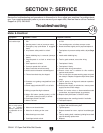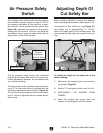
-32-
G0644 15" Open-End Wide Belt Sander
Conveyor Belt
Tracking
If the conveyor belt tracks to either side, the
belt could become damaged and have to be
replaced.
Adjusting the conveyor belt tracking is a balancing
process that takes patience and some trial-and-
error. You must tighten the loose side adjusting
bolt (the side the belt is tracking towards) to make
the belt move to the middle of the rollers, then
loosen that same adjusting bolt to make the con
-
veyor stay in position.
To adjust the conveyor belt tracking:
1. Make sure the conveyor is properly tensioned
(Page 30).
1. Turn the conveyor ON and watch it track.
2. Determine which side the conveyor belt is
tracking towards, and tighten the adjustment
bolt (see
Figure 32) on that side until the belt
tracks in the opposite direction.
Note: Tracking changes may take a couple of
minutes before they are noticeable.
3. When the conveyor belt is near the middle
of the rollers, loosen the same adjusting bolt
until the conveyor stops moving to the side
and tracks straight.
— If the belt tracks too far to the other side,
tighten the adjusting bolt as necessary to
bring it back, then repeats Steps 2 & 3 until
the tracking is correct.
conveyor tracking
Gib Adjustment
The gib controls the accuracy of sanding cabinet
movement along the dovetail way. A tight gib
makes the movement more accurate, but harder
to move, and will lead to premature wear of the
ways. A loose gib makes the movements and
measurements sloppy, but easier to move. The
goal of gib adjustment is to remove unnecessary
sloppiness without causing the dovetail way to
bind.
To adjust the gib:
1. DISCONNECT THE SANDER FROM
POWER!
2. Clean and lubricate the dovetail way and
gears (
Page 26).
3. Loosen the four gib jam nuts along the col-
umn shown in
Figure 34.
4. Adjust the gib set screws evenly until there is
a slight drag on the dovetail way as you move
the sanding cabinet up and down.
5. Re-tighten the gib jam nuts.
Figure 34. Gib jam nuts and set screws.
Gib Jam Nuts
& Set Screws
gib adjustment


















